About 400 people have died every year on Oregon roads for each of the past 20 years. Now a new plan adopted by the Oregon Transportation Commission on October 15th says the state has 20 years to bring that number down to zero.
Facing a second consecutive year of a double-digit increase in road fatalities, the the 177-page Transportation Safety Action Plan lays out a path to tackle the problem.
It’s the fourth Transportation Safety Action Plan adopted by Oregon since 1995. The previous plan was adopted in 2011. Beyond a useful roadmap to safer streets for policymakers and citizens, the plan also fulfills a requirement of the Federal Highway Administration. If Oregon wants to tap into federal safety funds, they must have a plan like this on file.
But it’d be a shame if the plan got stuffed into a file to just gather dust because the data and directives in the plan are essential knowledge.
For instance, the more than 230,000 traffic crashes that happened in Oregon between 2009 and 2013 had a total societal cost of $15.6 billion — about $785 per year for every Oregon resident. In that same time period 1,675 people were killed and over 7,000 people were seriously injured using our roads.

Overall we’re pleased at some of the language in the plan. It includes the most firm commitment the State of Oregon has ever made to achieving zero traffic fatalities. The plan never refers specifically to “vision zero” — the moniker adopted by 21 cities nationwide (including Portland) — but it unequivocally states that the Oregon Department of Transportation will work toward zero deaths by 2035.
This is a significant shift since 2011. The new plan mentions “zero” in regard to fatalities and injuries over 30 times. The 2011 plan mentioned it only twice.
“Transportation crashes and resulting injuries have historically been considered by many as an inevitable consequence of mobility,” reads the executive summary. “However, more recently this idea has been challenged as countries, states, and cities across the world seek to change safety culture and eliminate traffic fatalities and life-changing injuries entirely. The idea may be difficult to grasp initially, but when people are asked how many traffic fatalities are acceptable for their friends and family, the universal response is: ‘zero’.”
And in the section that describes “strategic investments” (Goal 6 in the plan), it states,
Oregon is committed to zero transportation-related fatalities and serious injuries. To make progress and improve traffic safety, stakeholders and partners are tasked with coordinating priorities, leveraging joint resources where possible, and utilizing quantitative data-driven tools (e.g., benefit-cost analysis). Funds are limited, therefore projects, programs, and policies will need to be prioritized to focus on those treatments which will have the greatest benefit toward achieving the vision of zero fatalities and serious injuries.
Advertisement
Compare the excerpt above with the 2011 version (notice how much weaker the “zero” language is):
The Oregon Transportation Safety Action Plan envisions a future where oregon’s transportation-related death and injury rate continues to decline. We envision a day when days, then weeks and months pass with not a single fatal or debilitating injury occurs. someday, we see a level of zero annual fatalities and few injuries as the norm.
Unless we design our roads for the speeds that are appropriate within the land use and geographic contexts and the types of users expected, crashes will also continue as before.
— Oregon Transportation Safety Action Plan, page 37
We also like the urgency in statements like this: “The development of the [plan] is an important step toward continuously changing the traffic safety culture in Oregon. It comes at a pivotal time as it is imperative to counteract the recent fatality increase.” It’s encouraging to see that ODOT is not ignoring the sobering spike in fatalities.
The plan also includes an entire section on the human impact of crashes with some frank language about the impact of road design on safety outcomes. “Unless we design our roads for the speeds that are appropriate within the land use and geographic contexts and the types of users expected, crashes will also continue as before.”
The plan outlines six specific “goal areas” with related actions that must be taken to meet the 2035 zero fatality goal: safety culture; infrastructure; healthy, livable communities; technology; collaborate and communicate; and strategic investments. To us, that feels like a great balance of soft (culture change) and hard measures (infrastructure).
The state’s goal is to create a safety culture, “where safety is integrated into everyday decision-making.” When it comes to infrastructure, the plan says roads should be designed in such a way that, “small user mistakes will not result in serious injuries.” Severity of crashes can be limited, the plan advises, “By creating environments that minimize potential conflicts… and implementing countermeasures with known or high potential to minimize crash severity and frequency.”
One of the six goal areas (Goal 5) speaks to the importance of working collaboratively with other agencies — something ODOT must improve on if we are ever going to complete a jurisdictional transfer and/or improve deadly arterials like 82nd Avenue and Powell Boulevard.
People who ride bicycles are addressed in a section of the plan that outlines four broad “emphasis areas”. Under the heading of “vulnerable users” the plan includes a section on “bicyclists”:
Bicycle fatalities and serious injuries can be caused by inattentive drivers or inattentive bicyclists.
Regardless of who is at fault, crashes involving a bicyclist tend to be more serious because bicyclists are completely exposed when using the transportation system. Nationally, as well as in Oregon, urban areas are developing transportation systems and land use policies to promote healthy communities and lifestyles. Alternative transportation infrastructure, including bike lanes, bike-specific traffic signals, and bike racks, are being implemented to encourage residents to bike to work, run errands, or for recreation. In the City of Portland, 7.2 percent of commuters go by bike, which is the highest percentage of commuters for a large American city. As bicycling environments improve and more people ride bikes, there are more chances for bicycle-vehicle conflicts. In
Problem Identification
Between 2009 and 2013, crashes involving bicyclists (pedalcyclists) accounted for 4 percent of all the fatal and serious injury crashes in Oregon and contributed to 42 fatalities and 293 serious injuries. About 86 percent of these crashes occurred in an urban environment, where there are more bicyclists and bicycle infrastructure. A number of bicycle-related fatal and serious injury crashes result from young driver crashes. Older driver crashes and crashes when aggressive driving is involved are also strongly correlated to bicycle crashes.
Unfortunately, the list of “Bicyclist actions” on page 84 is pretty weak:
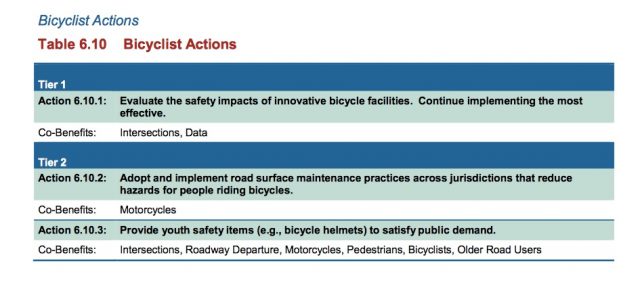
The plan is also a treasure trove of data and charts that should be put to use by citizen activists, policymakers and professional advocates. We can’t get where we need to go if we don’t know where we’ve been and where we stand today.
Here’s the overall fatality trend over time:
The chart below shows where the bad things happen:
Take a closer look at the plan for yourself and keep it nearby for future activism work. If you have takeaways, we’d love to hear about them in the comments.
— Jonathan Maus, (503) 706-8804 – jonathan@bikeportland.org
BikePortland is supported by the community (that means you!). Please become a subscriber or make a donation today.

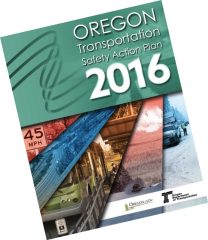

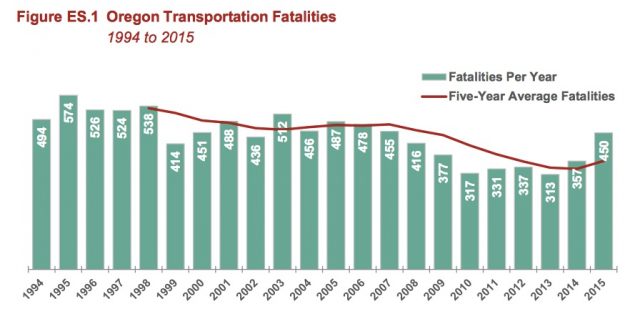

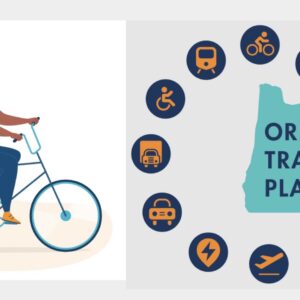

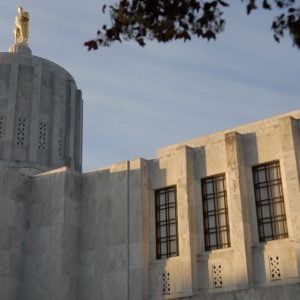

Thanks for reading.
BikePortland has served this community with independent community journalism since 2005. We rely on subscriptions from readers like you to survive. Your financial support is vital in keeping this valuable resource alive and well.
Please subscribe today to strengthen and expand our work.
I hate to sound like a broken record, but words in a plan improve safety as well as paint protects cyclists.
Those words are just fine. Now show me your budget.
Agree with you Paul. Just keep in mind though, that budgets are usually based on words in plans.
If they were, then why is PBOT taking $25M from PDC for a parking garage, while spending next to nothing on safety projects for people walking and cycling?
It’s a new plan, just released on the 15th of this month. Probably will take some time to persuade people to put a lot more of their dollars than they are now, into projects for walking and biking. As well as the fact, based on the figure cited in the Oregon Transportation Commission document, that just 7.2 percent of commuters in Portland, travel by bike; in part because of high use of motor vehicles for travel, motor vehicle travel continue to get a basically proportionate amount of dollars spent on infrastructure for driving.
I think it’s a great idea that Oregon may be more interested than ever before, in providing infrastructure that will enable walking, biking, and even skateboarding, to be the good, practical means of travel they all have the potential to be. Despite that good intention, it’s a simple fact also, that many people will continue to need to drive, and so logically it follows, there will need to be places for cars to be parked.
Infrastructure that’s better for walking and biking, surely would be welcome though, I believe to many people. Out here in Beaverton, for sure. Make the infrastructure not only safe and functional, but enjoyable to use as well, and many more people may become interested in taking the opportunity to use it.
Simple things in recent years have helped; such as pedestrian activated flashing beacons. I’m seeing these signals on Millikan Way and Baseline Rd out in Beaverton, and they’re appearing to be very effective. Reducing speed limits on many roads, or sections of them at least, from 40-45, down to 20-25, could be a huge boon to safety, and livability, for everyone using the road.
Because PDC has their own agenda, and if you want their money, you do with it what they ask.
The parking lot has more to do with PDC being concerned about its own survival than it does with any transportation plan (or lack thereof) for cars and/or bicycles. PDC should be shut down as it has outlived its usefulness; but the bureaucratic machine marches on.
Clearly moving forward according to an effective plan is what we all want to see, and without a plan it’s tough to imagine we’d see directed effort.
Also I’m looking at the previous plan (found here: http://www.oregon.gov/ODOT/TS/docs/tsap_revised_03-20-12.pdf) and I see language in it that looks wonderfully hopeful. For example:
“Action 32
Safety Weighted as Highest Consideration
Develop a plan or series of plans and policy
changes designed to improve the likelihood that
when construction or repair decisions are made,
safety is the highest weighted consideration. ”
So please forgive me if I’m quite skeptical they’ll be any more effective at following the new plan.
I wish more new bikes had reflective paint like Norco bikes.
Huh. I wish more new cars weren’t grossly overpowered. The last car I drove, a middling sort of SUV (no economy cars available!) was so flighty it was kind of hard to go 20 mph. I had to feather the gas pedal and watch it like a hawk.
I wish drivers actually paid attention and didn’t hit people/things with their cars constantly.
I don’t constantly hit things with my car.
Good, good, good. Now if you can just get the rest of the folks in your driving community to do better we’ll all be fine. Not constantly hitting things might be too low of a bar but it would be a good start.
http://i.imgur.com/ADKFKpa.gifv
They don’t.
Roughly 100 dead people per day in the US; thousands injured. The mayhem is pretty constant. Actually, it has been trending up lately, so perhaps constant isn’t the correct term.
I understand that individual drivers are not constantly hitting things. As a collective, drivers are, however. I was responding to someone who seems to think that all bicycles sold should be neon yellow, as if that were the reason why people are getting injured and killed on the roads.
The plan’s actions, if implemented, will greatly improve safety for all modes. Most important: Oregonians will need to hold primarily ODOT (including DMV) accountable for implementing it. If anyone has questions about the process let me know. (I served on the Policy Advisory Committee as the rep for Oregon Walks.)
I’ve heard the “safety for all modes” line from ODOT before, and it means safety and convenience for drivers, drivers, drivers, and more convenience for drivers, then maybe helmets and shaming for cyclists. The plan and even budget mean nothing as long as we have stretches of Barbur with no bike lane and 4 lanes at 12ft each with 45mph signs and 55mph drunk traffic. If we can’t close *one* lane to make a road safe, just close them all?
Here’s a simple idea that will improve safety and efficiency for all modes: enforcement of ORS 550.811 (17), which prohibits parking within 20ft of a crosswalk at an intersection. Just think how much easier and safer it would be if road users could see clearly at intersections.
Leah Treat says that enforcement of this statute is “complaint driven,” but that’s BS because the city has hundreds of marked parking spaces in direct violation of the law.
The real reason the law isn’t enforced? It would inconvenience folks who want to store their private automobiles in the right-of-way. More convenience for drivers, drivers, drivers.
Daylighting crosswalks….yet another application for DIY Safe-Hit posts. Let it rain Safe-Hit.
maybe we could buy some red paint for PDX Transformation and have them go on a corner curb painting spree…
if the city removes it they’ll be encouraging breaking the law…
Yellow paint.
I dont believe there is a secret cabal of car owners that is actively prohibiting the enforcement of this reg….pls stop the mindless car v bike meme that goes nowhere. I’d wager most drivers (many who also bike and many sometimes actually walk) would appreciate intersections that had unobstructed sightlines
Unobstructed sightlines lead to higher speeds for people driving cars. And the higher the speed the lower the compliance for stopping for people walking.
ok…so chaos (cars parked to the corners obstructing sight lines) as a traffic calming technique…not sure if you were serious or cynical in that statement, but it is also more difficult to safely stop for a pedestrian when you can’t fully see them until the last second because an SUV is parked at the corner.
It’s a very public, loud cabal.
Yeah, it’s no secret…
I don’t believe that there’s a secret cabal opposing this regulation either. I do know that there is vocal outcry any time the city proposes removing street parking. It’s politically unpopular, and no public official so far has had the guts to do what’s right.
whoops – meant to type ORS 811.550 (17)
Vision zero is being implemented on top of existing infrastructure. It would be great if we were starting with an empty field and building Portland from scratch using vision zero, but it isn’t. That means that retrofitted fixes are going to inconvenience everyone, drivers, cyclists and pedestrians.
So far I’ve seen diverters, bike boxes, greenways, traffic calming and other implementations that have been an inconvenience to drivers more than anyone else. And we will see pedestrian/bike overpasses and other infrastructure that will mean those who walk and ride will have to take a little extra time to get to where they need to go safely, just as the above changes have done to drivers.
So don’t make this out to be simply making life better for drivers at the expense of everyone else. This is going to take compromise from everyone to achieve.
I think the reason it appears, right now, that everything is being done to inconvenience drivers and no one else, is that for years and years, DoTs of all stripes have done everything to inconvenience everyone else EXCEPT for drivers.
Think of it as just righting a wrong instead of “bending over backwards to kowtow to bikes and pedestrians”. Making it a more level playing field to start of with, then moving forward with inconveniencing everyone across the board equally.
Yep. When you are used to privilege, any attempt to level the playing field will seem like oppression.
We actually want to discourage burning fossil fuels, using excessive amounts of energy, and excessive noise and road wear. With that taken into account, level and fair means making able-bodied SOV drivers feel like they would rather be on a bike, even if they don’t like to ride.
“…DoTs of all stripes have done everything to inconvenience everyone else EXCEPT for drivers. …” kristen t
I don’t think DOT’s have designed and built to inconvenience everyone but people driving. True, that the result of lots of infrastructure provided over the years, gave short shrift to people biking and walking, but I think that was due to the consequence of a long term lack of significant interest in walking and biking. People wanted, or needed to drive, so the DOT’s gave them the infrastructure for that kind of travel.
Some people may think so, but roads can’t realistically be built infinitely wide to handle infinite increases in motor vehicle travel. There are limitations, so when it comes to ‘either or’, people have tended to choose infrastructure for driving, over infrastructure for biking and walking. And the DOT’s comply with the people’s wishes.
While I think you have a good point – elections are decided by voters – I think you miss a number of ways that people’s preferences get translated into policy in a way that allocates more resources to driving than the average policy preference of all Portlanders, Portland metro area residents, or Oregonians would advocate:
*Not everyone CAN vote. (For example, kids, who can walk, bike, or take transit, but can’t drive, can’t vote. Non-citizens are likely to be poorer and also likely to take non-car modes of transportation – they also can’t vote.)
*Not everyone who can vote, does. (Low-income folks and differently abled folks are more likely to take non-car modes of transportation, and also less likely to vote).
*Once people vote, not everyone continues to advocate for what they want to elected officials and bureaucrats. (Low-income and minority communities are also time-poor, speak non-English languages, and aren’t as comfortable around the avenues of power. These communities are also more likely to take non-car modes of transportation).
*Of those who advocate, not everyone has an equal voice. (Lobbyists and the rich are more likely to be successful in advocating politically due to the influence of money in our elections. These folks are also more likely to be advocating for car infrastructure than non-car infrastructure because that’s what their companies use or what they personally use).
And to see how this biased translation worked out in the Portland metro area – almost a quarter of trips are taken by non-car modes of transportation per this report. http://www.oregonmetro.gov/news/you-are-here-snapshot-how-portland-region-gets-around
Do you think that almost a quarter of our transportation-related land or public money goes to walking, biking and transit?
“And to see how this biased translation worked out in the Portland metro area – almost a quarter of trips are taken by non-car modes of transportation per this report. http://www.oregonmetro.gov/news/you-are-here-snapshot-how-portland-region-gets-around
Do you think that almost a quarter of our transportation-related land or public money goes to walking, biking and transit?” alex reedin
I don’t know what the money percentage figures are for respective travel modes. Browsed over the Metro document you provided the link to. Lots of material there, in such a brief look, too much for me to simply summarize as to percent of money spent on travel mode for trips made by means other than by car, compared to use of the same infrastructure for travel by car…as well as other uses made of the same infrastructure for purposes other than personal trips, such as commercial hauling.
Increased need and desire for infrastructure that’s better for walking and biking, to me, seems to me to be a gradually evolving thing. Maybe many more people in Portland than have in past, are asking for big improvements to infrastructure they don’t have to use a car to get around on. Maybe that accounts for why Portland elected officials have been feeling prepared to allocate money for some of the recent bike and walk projects taken on, where they wouldn’t have in the past.
Efforts towards improvements for better and safer infrastructure for walking and biking, aren’t likely to be successful if they’re made on ‘us vs them’ analogies. Deciding how best to provide for people’s travel needs, isn’t a game.
Money DOT’s receive to provide road and street infrastructure to meet people’s travel needs, doesn’t just magically appear out of the blue, to spend any which way the dept’s want; that money is ours, the public’s, and the dept’s allocate the money to projects according to greatest need, expressed to them by the public.
Gradually, it looks like more people are slowly becoming interested in better infrastructure for walking and biking. For years though, decades, infrastructure primarily to support travel for driving, has been, and largely still is, what by far the greatest majority of the public apparently continues to demand and expect from their departments of transportation.
Get the public to provide more money for biking and walking…or get them to support splitting up the existing budget differently…and the money for better, safer biking and walking infrastructure, could become available.
Every survey I’ve ever seen of the public shows they want significantly more of their dollars spent on walking and biking than DOTs spend that way. Like, on the order of 20 or 25 cents of every dollar, instead of the penny or two we currently spend.
The underlying agreement is there. It’s just the public isn’t well enough organized to demand dollars actually get spent to meet their priorities, in part because transportation funding is very confusing and complex, with lots of different pots of money being moved around, and projects meeting multiple goals.
In our part of the Portland metropolitan area, anyway, the issue isn’t what to do, it’s money. The plans have existed for some time but there is no money to fund them. Progress depends on the state legislature because local funding measures like the gas taxes just don’t generate enough money.
In my neighborhood, I have seen poor choices made on important projects that generate or don’t address conflict among transportation modes because there isn’t enough money to build the right one.
The plans are too expensive because they’re designed to support more auto traffic instead of less. We have space on the road, we’re just not using it in the best possible way.
People driving, pay the lion’s share of the money. DOT’s have to provide for increases in more motor vehicle use, because traveling in motor vehicles is how the majority of road users get around. That’s the dilemma.
In a hypothetical scenario, there could be some visionary DOT head deciding to build bike lanes, bike highways, and pedestrian esplanades…instead of widening roads to accommodate increases in travel by motor vehicle. Rather than adding bike and walk stuff…in addition to…needed infrastructure for increases in motor vehicle travel.
What happens as a result? All the people that can’t get to where they need to go by means other than motor vehicle, find their trip time doubled, tripled, etc. Traffic jams up, and the bike lanes and esplanades are comparatively empty. People paying the bill, frustrated about traffic congestion stalling them in traffic, find themselves asking: ‘What gives?’.
People driving cars on roads may be paying slightly more money, but not covering the damage done by their driving. What gives?
Remove the cars from the roads and what do we need to pay for? We could probably shut off all of the traffic signals (do drivers even pay enough to cover the power bill for those?) What we have isn’t “paid for” by drivers, drivers have socialized the lion’s share of their expenses.
Without concrete funds dedicated to safety, this plan won’t work. Ultimately, ODOT will take the cheapest route, which usually manifests as a helmet-shaming, hi-vis campaign. It’s not as if ODOT doesn’t have the money – they chose to build a $70M highway interchange in the middle of nowhere so people could drive to an outlet mall. When ODOT says “funds are limited” for safety, what they really mean is “we don’t consider safety a high priority”.
The plan’s statement, “… when people are asked how many traffic fatalities are acceptable for their friends and family, the universal response is: ‘zero’,” is belied by people’s personal actions.
In our country the odds of one’s being killed in a motor vehicle crash are about 1 in 10,000 each year. Motorists understand, if only subliminally, that this number is very small, so they keep on motoring. If one drives 50 years or so over a working lifetime the odds accumulate and the chances become about 1 in 200, still acceptable to almost all motorists.
The only way to greatly reduce or eliminate deaths by motor vehicles is wholesale reduction or elimination of motoring, especially personal motoring. Everything else is just marginal.
Death by motoring is a complex conflation of personal psychology and social standards, a conundrum not readily resolved.
Getting rid of personal motoring might go a long way, provided the replacement doesn’t involve human judgments about distance or speed.
I base this on observations made last night while driving from E. 82nd and Prescott to E. 96th and Main (a distance of less than four miles). During that short trip, I observed five individuals run red lights. And I don’t mean scooting through a profoundly yellow light. In two cases, the individuals in question did not even enter the intersection until after opposing traffic lights had changed to green. It was just good fortune and wise habitude that folks waiting for the lights to change looked before they leaped into the fray. My count does not include left-turn violation from folks with hoods stuck far out into the intersections at left turn signals.
I don’t see things changing unless we can dramatically improve the competence of the pilots.
But, while the odds seem thin, our country has far worse outcomes than many other developed nations. Also those odds in the US vary greatly based on location. If you live in D.C. or the commonwealth of MA your odds of dying are far far lower than if you live in Montana or Wyoming.
While I understand the cynicism from many of the posts here I, for one, am thrilled that ODOT is even talking about this. Yes it may just be words and a proposal but it has to start somewhere and frankly I wasn’t expecting this for another five years. Turning the ship of government is excruciatingly slow. Many of us can attest to how long it takes the powers that be to even acknowledge that our position is valid much less do something about it.
I have seen significant changes happening within the department in my region and recently had an interesting exchange with three employees during a city open streets festival. The issue was rumble strip installation on a high lane departure corridor. Prior to this I learned from a motorcyclist that our strips are exceptionally dangerous to those riding. As you might imagine many EU countries have adopted a different, safer, design. So I put it to these guys as I met them along the ride.
The long-time engineer basically responded like you would expect and blew me off. The ten-year vet was interested and sympathetic but said the best he could do was mitigate their placement to lower the chances of the problem happening. The newbie, who’s job is to work within their projects and make them safe for all users, had heard about the new designs, was hoping to see them in tests and was advocating for the change within the dept.
I think that this is a big shift for ODOT and the fact that the younger employees within their system seem to “get it” gives me hope that V0 is more than just words, charts and pamphlets.
But, while the odds seem thin, our country has far worse outcomes than many other developed nations. Also those odds in the US vary greatly based on location. If you live in D.C. or the commonwealth of MA your odds of dying are far far lower than if you live in Montana or Wyoming.
Reduction in driving is achievable and reduces potential for deaths in multiple ways.
I do not believe elimination of motoring is even desirable, but it is highly desirable to have as many alternatives as possible to it.